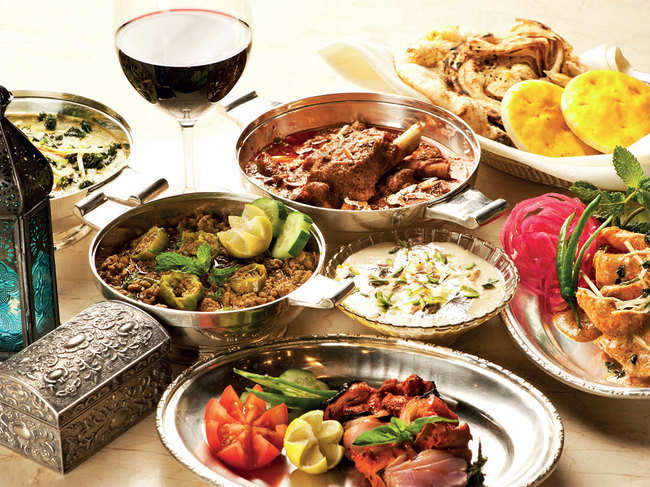 Agencies
AgenciesMuch before Heston Blumenthal’s mad experiments with multisensory dining, or modernist chefs collaborating with perfumers and “scent composers” like Christophe Laudamiel (who looks at perfumes as sculptures and has composed scents for an entire opera, amongst other things), Indian cuisines recognised the importance of smell in the way we taste our food.
Perfumery in foods has been a part of many of India’s courtly cuisines — from Awadh to Marwar and Delhi to Hyderabad — though today the scent of that tradition seems to have become just a whiff. From qormas and kebabs to breads, rice and desserts, dishes cooked with sophistication by chefs patronised by the elite were distinctive, not just because of better ingredients or refined cooking but also because of the way they were perfumed.
In fact, perfumery was one of the key ways in which a rich man’s food differed from dishes cooked for the masses— which is why most street food dishes do not deploy fragrance quite the same way as elegantly cooked home-style dishes.
Natural ingredients such as the distillate of flowers, of roots and fruits and woods like sandal and oud were used to add top notes while finishing these dishes.
Itr or attar have been a tradition in India since the Mughals apparently popularised their production and use, influenced by Central Asian traditions of perfumery with flowers. Empress Nur Jahan is supposed to have bathed in rose water and Jahanara Begum, emperor Shah Jahan’s daughter, apparently spiked her Shirazi wine with rose water.
It was thanks to this patronage of perfumery that Kannauj, the town along the Ganga, became India’s attar capital, where every family is still engaged in one way or the other in the business. Like Persian, Turkish and Egyptian traditions, Indian attars are oil-based, where the essences of flowers and woods are distilled using sandalwood oil as a base. The western tradition uses alcohol as base.
 Agencies
AgenciesMany of these perfumes were food grade and used with precision by master chefs cooking Mughlai or later Awadhi food. In fact, how masterfully a dish was cooked could — and still is — be judged by just the whiff of the meetha itr or kewra (screwpine) essence wafting from, say, a dish of the biryani.
 Agencies
AgenciesToo much fragrance and the chef could drown out its subdued spicing and other flavours — after all, the superiority of a biryani is equally determined by the smell of the rice (Dehradun basmati in the Awadhi version). However, a perfect Awadhi biryani or qorma can still draw you in by its top floral notes used with restraint.
“The idea behind using these fragrances was not just because they are pleasing but also because according to Unani medicine, these ingredients were thought to be cooling digestives. Food perfumed with these was part of the Nawabi etiquette to take care of bodily odours,” says chef Ghulam Quereshi of Dumpukht, the luxury restaurant serving a slice of old Lucknow.
Meetha itr, literally “sweet fragrance”, remains a mystery despite its use in Awadhi, old Delhi and Kolkata-style Mughlai cuisines. Most chefs will show you tiny vials of it retailed from a handful of old perfumeries.
But what exactly is it? Chef Quereshi says it was traditionally made of distillate of flowers collected from mazaars of Sufi saints. Every mazaar had a pit where flowers were collected, dried and later their essence was distilled.
If orange blossom water is a major fragrant in Turkish and Moroccan cuisines, rose water and rose rou (essence distilled sandalwood oil) has been key to sophisticated flavours in Indian gastronomy.
From desserts like gulab jamun and phirni or kheer to game meats, partridge and quail to breads sprinkled with rose water and post-prandial paan, roses have traditionally perfumed many of our foods.
In fact, in Kannauj, one of the biggest buyers of attars was the food industry and gutka makers. This is on the wane today since pure gulab rou costs upwards of Rs 12 lakh per litre and the cost of sandalwood oil itself having gone up manifold.
 Agencies
AgenciesCheaper fragrances with chemical bases have replaced the attars, including edible grade ones. That is also why today, we are hard put to find delicacies such as the Marwari boondi sprinkled with rose essential oil — where the flavour was determined by the purity of the natural fragrance.
Chefs the world over are interested in “neurogastronomy”, an emerging field. The term was coined by Yale neurobiologist Gordon Shepherd studying olfaction, who postulated that our appreciation of what is in the mouth is created by the brain. Today, chefs recognise that “flavour” is more powerful than “taste” because it involves all the senses and can conjour up memory, nostalgia and different moods. Flowers in Indian cooking have always done that, elevated moods, played on nostalgia, used as much for their smell as colour.
Persian scholar Salma Husain points out how mahua, chameli and harsingar were used in food for their fragrances.
“Rice was flavoured with chameli flowers by putting these on a thin muslin cloth over steaming rice and then the entire dish would be finished on dum.”
Harsingaar (night jasmine) was used to colour foods before saffron became popular.
Then there are woods such as sandal and oud, both perfume ingredients in the western tradition too that have always been used to smoke dishes. With Holi around the corner, these fragrances are definitely in the air. Perhaps they should be on your plates and palates too.
The writer looks at restaurant trends, food history and culinary cultures.
(Catch all the Business News, Breaking News, Budget 2024 Events and Latest News Updates on The Economic Times.)
Subscribe to The Economic Times Prime and read the ET ePaper online.
(Catch all the Business News, Breaking News, Budget 2024 Events and Latest News Updates on The Economic Times.)
Subscribe to The Economic Times Prime and read the ET ePaper online.










 Get Unlimited Access to The Economic Times
Get Unlimited Access to The Economic Times
